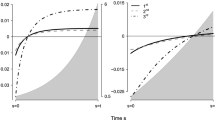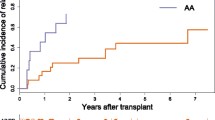Abstract
A generalized case-cohort design has been used when measuring exposures is expensive and events are not rare in the full cohort. This design collects expensive exposure information from a (stratified) randomly selected subset from the full cohort, called the subcohort, and a fraction of cases outside the subcohort. For the full cohort study with competing risks, He et al. (Scand J Stat 43:103-122, 2016) studied the non-stratified proportional subdistribution hazards model with covariate-dependent censoring to directly evaluate covariate effects on the cumulative incidence function. In this paper, we propose a stratified proportional subdistribution hazards model with covariate-adjusted censoring weights for competing risks data under the generalized case-cohort design. We consider a general class of weight functions to account for the generalized case-cohort design. Then, we derive the optimal weight function which minimizes the asymptotic variance of parameter estimates within the general class of weight functions. The proposed estimator is shown to be consistent and asymptotically normally distributed. The simulation studies show (i) the proposed estimator with covariate-adjusted weight is unbiased when the censoring distribution depends on covariates; and (ii) the proposed estimator with the optimal weight function gains parameter estimation efficiency. We apply the proposed method to stem cell transplantation and diabetes data sets.

Similar content being viewed by others
References
Andersen PK, Klein JP, Rosthøj S (2003) Generalised linear models for correlated pseudo-observations, with applications to multi-state models. Biometrika 90(1):15–27
Austin PC, Fine JP (2017) Practical recommendations for reporting f ine-g ray model analyses for competing risk data. Stat Med 36(27):4391–4400
Barlow WE (1994) Robust variance estimation for the case-cohort design. Biometrics 50(4):1064–1072
Borgan O, Langholz B, Samuelsen SO, Goldstein L, Pogoda J (2000) Exposure stratified case-cohort designs. Lifetime Data Anal 6(1):39–58
Cai J, Zeng D (2007) Power calculation for case-cohort studies with nonrare events. Biometrics 63(4):1288–1295
Cullen K (1972) Mass health examinations in the busselton population, 1966 to 1970. Med J Aust 2(13):714–718
Dignam JJ, Zhang Q, Kocherginsky M (2012) The use and interpretation of competing risks regression models. Clin Cancer Res 18(8):2301–2308
Duncan BB, Schmidt MI, Pankow JS, Ballantyne CM, Couper D, Vigo A, Hoogeveen R, Folsom AR, Heiss G (2003) Low-grade systemic inflammation and the development of type 2 diabetes: the atherosclerosis risk in communities study. Diabetes 52(7):1799–1805
Fan C, Ma H, Zhou Y (2018) Quantile regression for competing risks analysis under case-cohort design. Biometrics 88(6):1060–1080
Fine JP, Gray RJ (1999) A proportional hazards model for the subdistribution of a competing risk. J Am Stat Assoc 94(446):496–509
He P, Eriksson F, Scheike TH, Zhang MJ (2016) A proportional hazards regression model for the subdistribution with covariates-adjusted censoring weight for competing risks data. Scand J Stat 43(1):103–122
Huang Y (2014) Bootstrap for the case-cohort design. Biometrika 101(2):465–476
Kalbfleisch JD, Prentice RL (2002) The Statistical Analysis of Failure Time Data, 2nd edn. Wiley, Hoboken
Kang S, Cai J (2009) Marginal hazards model for case-cohort studies with multiple disease outcomes. Biometrika 96(4):887–901
Kim S, Cai J, Lu W (2013) More efficient estimators for case-cohort studies. Biometrika 100(3):695–708
Kim, S., Xu, Y., Zhang, M.J., Ahn, K.W.: Stratified proportional subdistribution hazards model with covariate-adjusted censoring weight for case-cohort studies. Scandinavian Journal of Statistics, in press (2020+)
Kim S, Zeng D, Cai J (2018) Analysis of multiple survival events in generalized case-cohort designs. Biometrics 74(4):1250–1260
Kulich M, Lin D (2004) Improving the efficiency of relative-risk estimation in case-cohort studies. J Am Stat Assoc 99(467):832–844
Langholz B, Thomas DC (1990) Nested case-control and case-cohort methods of sampling from a cohort: a critical comparison. Am J Epidemiol 131(1):169–176
Lee C, North K, Bray M, Couper D, Heiss G, Zeldin D (2008) Cyclooxygenase polymorphisms and risk of cardiovascular events: the atherosclerosis risk in communities (ARIC) study. Clin Pharmacol Ther 83(1):52–60
Lee U, Sun Y, Scheike TH, Gilbert PB (2018) Analysis of generalized semiparametric regression models for cumulative incidence functions with missing covariates. Comput Stat Data Anal 122:59–79
Lin D, Ying Z (1993) Cox regression with incomplete covariate measurements. J Am Stat Assoc 88(424):1341–1349
Mao L, Lin D (2017) Efficient estimation of semiparametric transformation models for the cumulative incidence of competing risks. J R Stat Soc: Ser B (Stat Methodol) 79(2):573–587
Parner ET, Andersen PK, Overgaard M (2020) Cumulative risk regression in case-cohort studies using pseudo-observations. Lifetime Data Analysis. https://doi.org/10.1007/s10985-020-09492-3
Pidala J, Lee SJ, Ahn KW, Spellman S, Wang HL, Aljurf M, Askar M, Dehn J, Viña MF, Gratwohl A et al (2014) Nonpermissive hla-dpb1 mismatch increases mortality after myeloablative unrelated allogeneic hematopoietic cell transplantation. Blood 124(16):2596–2606
Pintilie M, Bai Y, Yun L, Hodgson DC (2010) The analysis of case cohort design in the presence of competing risks with application to estimate the risk of delayed cardiac toxicity among hodgkin lymphoma survivors. Stat Med 29(27):2802–2810
Prentice RL (1986) A case-cohort design for epidemiologic cohort studies and disease prevention trials. Biometrika 73(1):1–11
Prentice RL, Kalbfleisch JD Jr, A.V.P., Flournoy, N., Farewell, V.T., Breslow, N.E. (1978) The analysis of failure times in the presence of competing risks. Biometrics 34(4):541–554
Scheike TH, Zhang MJ (2008) Flexible competing risks regression modeling and goodness-of-fit. Lifetime Data Anal 14(4):464
Scheike TH, Zhang MJ, Gerds TA (2008) Predicting cumulative incidence probability by direct binomial regression. Biometrika 95(1):205–220
Self SG, Prentice RL (1988) Asymptotic distribution theory and efficiency results for case-cohort studies. Ann Stat 16(1):64–81
Sørensen P, Andersen PK (2000) Competing risks analysis of the case-cohort design. Biometrika 87(1):49–59
Sun J, Sun L, Flournoy N (2011) Additive hazards model for competing risks analysis of the case-cohort design. Commun Stat - Theory Methods 33(2):351–366
Wacholder S, Gail M, Pee D (1991) Selecting an efficient design for assessing exposure-disease relationships in an assembled cohort. Biometrics 47(1):63–76
Wolkewitz M, Palomar-Martinez M, Olaechea-Astigarraga P, Alvarez-Lerma F, Schumacher M (2016) A full competing risk analysis of hospital-acquired infections can easily be performed by a case-cohort approach. J Clin Epidemiol 74:187–193
Zeng D, Lin D (2014) Efficient estimation of semiparametric transformation models for two-phase cohort studies. J Am Stat Assoc 109(505):371–383
Zhou B, Latouche A, Rocha V, Fine J (2011) Competing risks regression for stratified data. Biometrics 67(2):661–670
Acknowledgements
This work was supported in part by the Medical College of Wisconsin Cancer Center, the Advancing a Healthier Wisconsin Endowment (Project # 5520461), Institutional Research Grant IRG #16-183-31 from the American Cancer Society and the Medical College of Wisconsin Cancer Center, and the US National Cancer Institute (U24CA076518). The ARIC study has been funded in whole or in part with Federal funds from the National Heart, Lung, and Blood Institute, National Institutes of Health, Department of Health and Human Services, under Contract Nos. (HHSN268201700001I, HHSN268201700002I, HHSN268201700003I, HHSN268201700005I,HHSN268201700004I), with the diabetes ancillary study supported by National Institute of Diabetes, Digestive and Kidney Diseases Grant 5R01-DK56918-03. The authors thank the staff and participants of the ARIC study for their important contributions. Xu and Kim are equally contributed authors.
Author information
Authors and Affiliations
Corresponding author
Ethics declarations
Conflict of interest
The authors declare that they have no conflict of interest.
Additional information
Publisher's Note
Springer Nature remains neutral with regard to jurisdictional claims in published maps and institutional affiliations.
Supplementary Information
Below is the link to the electronic supplementary material.
Rights and permissions
About this article
Cite this article
Xu, Y., Kim, S., Zhang, MJ. et al. Competing risks regression models with covariates-adjusted censoring weight under the generalized case-cohort design. Lifetime Data Anal 28, 241–262 (2022). https://doi.org/10.1007/s10985-022-09546-8
Received:
Accepted:
Published:
Issue Date:
DOI: https://doi.org/10.1007/s10985-022-09546-8




